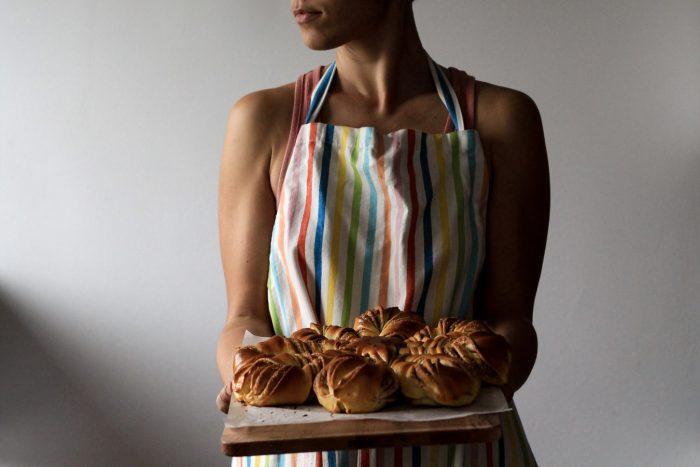In vegan cooking, pantry staples are essential.
They allow us to turn a few fresh veggies into a satisfying and nom nom nom meal in two shakes of a lamb’s tail—a happy lamb, because he knows he won’t be on the menu at your house.
There are a bazillion things a vegan will eventually have bursting out of her cabinets (and spice racks and closets and the back steps because we ran out of room), but if you’re just getting started, this list of necessities will go a long way.
Oil
There are almost as many oils as there are stars in the sky, but olive oil, vegetable oil and coconut oil will get you any place you need to be. Use them to sauté, roast, and drizzle on everything and even rub all over yourself for smooth supple skin. If you’re feeling extravagant, add sesame and peanut oil to your list.
Wine & Vinegar
Acid is such an important part of cooking, balancing sweet notes and bringing out the other flavors in a dish. I always keep a bottle of dry white wine on hand (cheap, but totally drinkable) as well as good balsamic and unfiltered apple cider vinegar.
Nuts & Seeds
As with oils, the variety of nuts and seeds is seemingly limitless. A starter pack should include walnuts, almonds, cashews and peanuts and sesame, flax and chia seeds. Between them, you can add fantastic flavor and great protein to absolutely any dish.
Dried Fruit
Dried fruit is great to snack on as is, and also amps up the flavor in unexpected ways in the rest of your cooking. It adds a meaty sweetness to stews in particular, and is a nice counterpoint to savory notes. Start by buying Medjool dates, golden raisins and dried apricots.
Nut Butter
Nut butter is obviously another wonderful source of protein and yummy to smear on an apple, some celery, a banana, bread, a bagel or just your forefinger—but you can also toss it into broth based soups and create something creamy and exotic instantly. Start with either peanut butter, sunflower seed, almond or cashew butter.
Dried Herbs & Spices
The world of spices is dizzying, but it is possible to cull them down and have a fairly succinct list which will transport you to the four corners of the culinary globe. If I had to clean up my spice act and just go with basics, I would have the following; chunky sea salt, whole peppercorns, curry powder, bay leaves, smoked paprika, cinnamon, nutmeg, oregano, sweet basil, red pepper flakes and fennel seed.
Bouillon
If your veggies just aren’t developing any richness of flavor in a soup or stew, a bit of bouillon will work wonders. I like Better Than Bouillon vegetable flavor paste, but really, any old cube will do. Find this in the soup aisle.
Aromatics
Aromatics are those veggies with a long shelf life and big, spectacular flavor that are critical to making vegan food pop. Every vegan cook must have fresh onions, garlic and ginger somewhere in the house. The onions and garlic will keep for months in a dark, cool cupboard. If somehow an onion starts to go bad, don’t toss it, just cut off the bad parts and use the rest. Store ginger in an airtight container in the freezer and when you need it, just grab it, skin on, rub it on a microplane grater until you have to amount you need, and then pop it back in.
Grains, Noodles, Squash & Potatoes
Starch is an efficient, delicious and cost effective way to bulk up your cooking. Miraculously, you can leave it sitting around indefinitely until you’re ready to use it. There are lots of choices, but a nice rounded list should include; brown rice, wild rice, quinoa, cous cous (unless gluten intolerant), fast cooking rice noodles, any kind of pasta (made from brown rice if gluten intolerant), any kind of potatoes (store with onions in a cool, dark place), and spaghetti squash (leave out on the counter for months).
Spaghetti squash is perfect when you’re trying to limit carbs—just use in place of any grain or noodle in any dish: split in half and bake face down in 1 inch of water for 45 in a 400 degree oven. Scrape out strands with a fork and store in an airtight container in the fridge up to one week).
Canned and Jarred
There are a huge number of canned and jarred foods that can either elevate flavor or add quick protein and bulk to your cooking—here’s a good place to begin. For flavor stock: soy sauce (or tamari), capers, greek olives, canned tomatoes, as well as sun dried tomatoes and for protein stock chick peas, kidney beans and black beans.
Sweeteners
I’ll make no bones about it, I’ve got a sweet tooth. Even if you don’t, you should have something to sweetify your food on hand. For low calorie sweeteners I stick to stevia, otherwise try pure maple syrup or brown sugar. I don’t use refined white sugar—I really don’t like the taste, nor do I use honey (not vegan) or agave nectar (heavily processed unless you find a village in Mexico where they make it properly).
Bonus: Handy Equipment
Assuming you already have the standard pots and pans, there are two other indispensable kitchen items I use almost daily.
First is a high powered blender (I like the Vitamix). You can throw anything in this sucker and it will come out liquid. Great for smoothies and soups in particular.
Second is a rice cooker. Some people decry the use of rice cookers, but they make things so convenient I’m a huge fan. Just toss in your grains and some liquid, flip the switch and walk away—it’s genius.
Having a fully stocked pantry gives vegan cooks the freedom to put together home made, nutritious, tasty food on the fly, and also gives us a framework within which to experiment and learn about the endless meat free flavors we can create.







Read 4 comments and reply